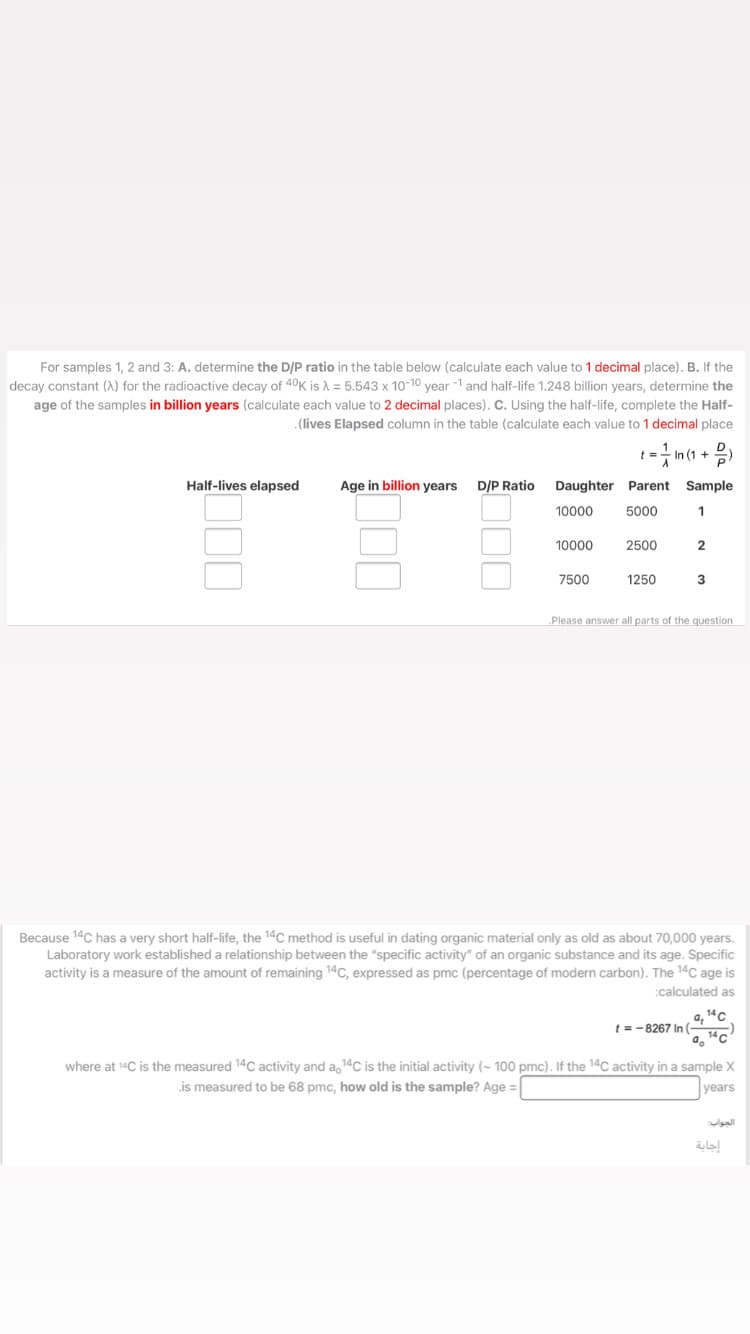For samples 1, 2 and 3: A. determine the D/P ratio in the table below (calculate each value to 1 decimal place). B. If the decay constant (A) for the radioactive decay of 40K is A = 5.543 x 10-10 year 1 and half-life 1.248 billion years, determine the age of the samples in billion years (calculate each value to 2 decimal places). C. Using the half-life, complete the Half- .(lives Elapsed column in the table (calculate each value to 1 decimal place Half-lives elapsed Age in billion years D/P Ratio Daughter Parent Sample 10000 5000 10000 2500 7500 1250 3
For samples 1, 2 and 3: A. determine the D/P ratio in the table below (calculate each value to 1 decimal place). B. If the decay constant (A) for the radioactive decay of 40K is A = 5.543 x 10-10 year 1 and half-life 1.248 billion years, determine the age of the samples in billion years (calculate each value to 2 decimal places). C. Using the half-life, complete the Half- .(lives Elapsed column in the table (calculate each value to 1 decimal place Half-lives elapsed Age in billion years D/P Ratio Daughter Parent Sample 10000 5000 10000 2500 7500 1250 3
Introduction to General, Organic and Biochemistry
11th Edition
ISBN:9781285869759
Author:Frederick A. Bettelheim, William H. Brown, Mary K. Campbell, Shawn O. Farrell, Omar Torres
Publisher:Frederick A. Bettelheim, William H. Brown, Mary K. Campbell, Shawn O. Farrell, Omar Torres
Chapter9: Nuclear Chemistry
Section: Chapter Questions
Problem 9.30P
Related questions
Question

Transcribed Image Text:For samples 1, 2 and 3: A. determine the D/P ratio in the table below (calculate each value to 1 decimal place). B. If the
decay constant (A) for the radioactive decay of 40K is A = 5.543 x 10-10 year -1 and half-life 1.248 billion years, determine the
age of the samples in billion years (calculate each value to 2 decimal places). C. Using the half-life, complete the Half-
.(lives Elapsed column in the table (calculate each value to 1 decimal place
Half-lives elapsed
Age in billion years
D/P Ratio
Daughter Parent Sample
10000
5000
10000
2500
7500
1250
Please answer all parts of the question
Because 14C has a very short half-life, the 14C method is useful in dating organic material only as old as about 70,000 years.
Laboratory work established a relationship between the "specific activity" of an organic substance and its age. Specific
activity is a measure of the amount of remaining 14C, expressed as pmc (percentage of modern carbon). The 14C age is
:calculated as
a, 14c
t =-8267 In(
where at 14C is the measured 14C activity and a, 14C is the initial activity (- 100 pmc). If the 14C activity in a sample X
is measured to be 68 pmc, how old is the sample? Age =
years
الجواب
Expert Solution
This question has been solved!
Explore an expertly crafted, step-by-step solution for a thorough understanding of key concepts.
This is a popular solution!
Trending now
This is a popular solution!
Step by step
Solved in 3 steps with 1 images

Knowledge Booster
Learn more about
Need a deep-dive on the concept behind this application? Look no further. Learn more about this topic, chemistry and related others by exploring similar questions and additional content below.Recommended textbooks for you

Introduction to General, Organic and Biochemistry
Chemistry
ISBN:
9781285869759
Author:
Frederick A. Bettelheim, William H. Brown, Mary K. Campbell, Shawn O. Farrell, Omar Torres
Publisher:
Cengage Learning


Chemistry: An Atoms First Approach
Chemistry
ISBN:
9781305079243
Author:
Steven S. Zumdahl, Susan A. Zumdahl
Publisher:
Cengage Learning

Introduction to General, Organic and Biochemistry
Chemistry
ISBN:
9781285869759
Author:
Frederick A. Bettelheim, William H. Brown, Mary K. Campbell, Shawn O. Farrell, Omar Torres
Publisher:
Cengage Learning


Chemistry: An Atoms First Approach
Chemistry
ISBN:
9781305079243
Author:
Steven S. Zumdahl, Susan A. Zumdahl
Publisher:
Cengage Learning

Chemistry
Chemistry
ISBN:
9781305957404
Author:
Steven S. Zumdahl, Susan A. Zumdahl, Donald J. DeCoste
Publisher:
Cengage Learning

Chemistry: The Molecular Science
Chemistry
ISBN:
9781285199047
Author:
John W. Moore, Conrad L. Stanitski
Publisher:
Cengage Learning

Principles of Instrumental Analysis
Chemistry
ISBN:
9781305577213
Author:
Douglas A. Skoog, F. James Holler, Stanley R. Crouch
Publisher:
Cengage Learning